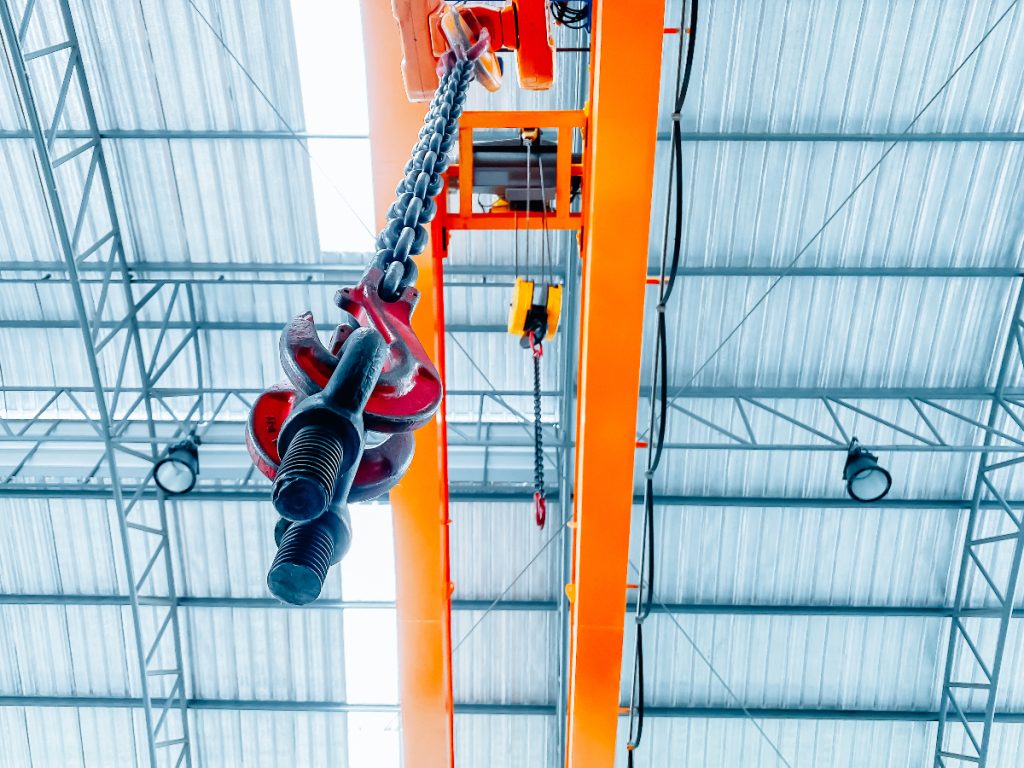As a production or manufacturing facility owner or general manager, you know how important industrial material handlers and cranes are for the production process. But you also know that no one crane fits all applications. Having a crane that lifts 100 tons sounds great, but if it doesn’t meet your needs, it doesn’t do much good. Storee Construction has been handling crane fabrication and installation throughout the Midwest for decades.
It also won’t do you much good–and it can be pretty dangerous, too–if it isn’t installed correctly. Storee Construction can repurpose your existing crane equipment more effectively and refit existing crane units to new spaces and needs. We have been specializing in crane fabrication and installation for decades and have worked with companies in Missouri and beyond.
Whether you need cranes on the loading dock, for food processing, or for any number of other industrial uses, we’ll audit your needs and design the best crane usage for your use.
Cranes: Fabrication and Installation
There are any number of crane types available to you for your production, manufacturing, and material handling needs. When integrated with other processes in your facility, you can speed production lines, increase efficiency, and improve safety–the most important step of any plant upgrade.
 Overhead Cranes
Overhead Cranes
Retrofitting your industrial plant with overhead or bridge cranes can significantly enhance efficiency and streamline material handling processes. Overhead cranes, mounted on beams or runways along the ceiling, offer numerous advantages in an industrial setting.
They optimize floor space by lifting and transporting heavy loads within a fixed area, allowing precise positioning of materials or machinery. These are prevalent in manufacturing setups, consisting of a bridge carrying a hoist that moves along a runway.
Customization options for span, lift height, and controls ensure the crane fits your facility’s specific needs. Safety features like limit switches, overload protection, and emergency stop systems are integral to prevent accidents and protect personnel, materials, and equipment.
Gantry Cranes
Similar to overhead cranes, gantry cranes operate on a track or rails but are supported by uprights rather than being suspended from the ceiling. Gantry cranes present an excellent solution for industrial plants, offering versatility and efficiency in material handling when there is limited overhead support.
These cranes, supported by uprights and equipped with wheels, can move along tracks or runways on the factory floor. Their adaptability allows for the handling of heavy loads across various work areas. Customization options, such as span width, lifting height, and control systems, will be aligned to fit your facility’s specific requirements.
Jib Cranes
Jib cranes stand out as a versatile and space-efficient solution for material handling needs. These cranes feature a horizontal arm (jib) that rotates around a vertical pillar or wall-mounted bracket, making them ideal for localized lifting tasks within confined work areas.
Jib cranes maximize space utilization, as they require minimal floor space while providing extensive coverage within their radius. Their ability to precisely position loads and maneuver in tight spaces makes them invaluable for various tasks, such as assembly line operations, transferring materials between workstations, and loading or unloading deliveries.
Crane Fabrication and Installation: Considerations
All cranes come in various configurations and load capacities, so we assess the weight and dimensions of the loads to be lifted to design optimal systems. Each type of crane serves specific purposes, enhancing productivity and safety within manufacturing facilities.
The choice of crane depends on factors such as load capacity, maneuverability, space availability, and the nature of the manufacturing process. By selecting the appropriate crane, you will optimize their operations, ensuring efficient material handling and workflow management.
Installation of overhead cranes may require structural modifications, so it’s essential to evaluate the building’s infrastructure to accommodate the crane’s support system. Upgrading with overhead, gantry, jib, and other cranes can revolutionize your facility’s material handling capabilities, making it a great investment that promises long-term gains.
Installation of gantry cranes might necessitate floor reinforcement to support the crane’s movements and loads. Additionally, incorporating safety features like limit switches, emergency brakes, and overload protection enhances workplace safety.
